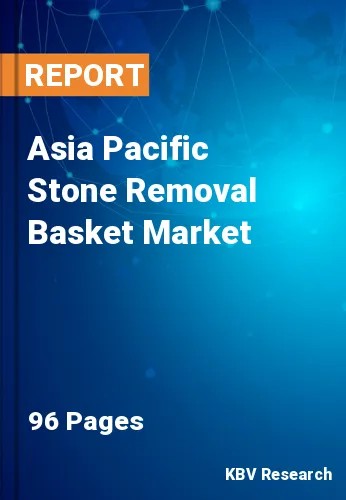The Asia Pacific Stone Removal Basket Market would witness market growth of 4.1% CAGR during the forecast period (2023-2029).
Kidney stones are tiny, hard deposits that form in the kidneys and are frequently difficult to pass. Concentrated urine contains a hard deposit of minerals and acids that clump together to create shard stones. Although a kidney stone can hurt when it passes, it cannot harm the body permanently. Severe pain, typically in the side of the abdomen, that usually ends in nausea are kidney stone symptoms. Painkillers and drinking lots of water are part of the treatment. Surgery may be necessary for a larger stone to fragment into smaller pieces.
Normally, the kidneys discharge chemicals and waste from the body through urine. Still, in the case of kidney stones, these substances may become restricted in the kidney or move from the kidney to the urinary tract and ureter. Therefore, removing kidney stones using a Basket is categorized according to the therapy method as extracorporeal shock wave lithotripsy, intracorporeal ureteroscopy, and percutaneous nephrolithotripsy. Extracorporeal shock wave lithotripsy uses shock waves to shatter big kidney stones into smaller pieces, allowing the smaller particles to pass more readily through the urinary tract and exit the body. Extracorporeal shock wave lithotripsy is performed for patients with stones between 4mm & 2cm in diameter.
China is also one of the countries that is aging the fastest. By 2040, it is anticipated that 28% of the population will be over 65. The nation's declining fertility rate and increased life expectancy are to blame for this. This presents a significant obstacle and a chance for socioeconomic and public health improvement. The region's aging population puts more people at risk for conditions like stone formation. In addition, new pain-relieving technology and treatments have created potential opportunities in the Japanese market. As a result, the demand for minimally invasive medical devices may increase throughout the region, helping the regional stone removal basket market grow.
The China market dominated the Asia Pacific Stone Removal Basket Market by Country in 2022, and would continue to be a dominant market till 2029; thereby, achieving a market value of $56.1 million by 2029. The Japan market is estimated to grow a CAGR of 3.5% during (2023 - 2029). Additionally, The India market would experience a CAGR of 4.7% during (2023 - 2029).
Based on Type, the market is segmented into Nitinol and Stainless Steel. Based on Shape, the market is segmented into Helical, Spherical and Paired Wire. Based on End User, the market is segmented into Hospitals, Specialty Clinics, Ambulatory Surgical Centers and Others. Based on Number of Wires, the market is segmented into 4 Wire Basket, 6 Wire Basket and 8 Wire Basket. Based on Tip, the market is segmented into Tipless and With Tip. Based on countries, the market is segmented into China, Japan, India, South Korea, Singapore, Malaysia, and Rest of Asia Pacific.
Free Valuable Insights: The Worldwide Stone Removal Basket Market is Projected to reach USD 715.6 Million by 2029, at a CAGR of 3.2%
The market research report covers the analysis of key stake holders of the market. Key companies profiled in the report include Boston Scientific Corporation, Advin Health Care, Cliniva Healthcare, Coloplast Group, Becton, Dickinson and Company, Olympus Corporation, Cook Medical, Inc. (Cook Group), Medi-Globe GmbH (Medi-Globe Group), UROMED Kurt Drews KG and MED-Fibers, Inc.
By Type
By Shape
By End User
By Number of Wires
By Tip
By Country
Our team of dedicated experts can provide you with attractive expansion opportunities for your business.

